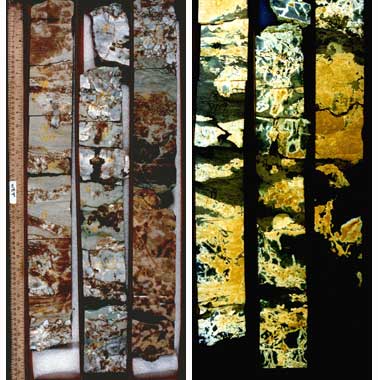| Kansas Geological Survey | Spring 1998 |
Vol. 4.2 |
|
Oil Field Study Reveals Subsurface Geology
CONTENTS Schaben Field Study–page 1
|
In
the history of Kansas oil exploration, Ness County’s Schaben field
probably doesn’t rate much more than a footnote. Someday it might
mean more. With funding from the U.S. Department of Energy, researchers
from The University of Kansas (Kansas Geological Survey, KU Energy Research
Center, and Tertiary Oil Recovery Project) are working with the field’s
operators to find ways of reviving Schaben. Shaben is important not because it is unusual, but because it is so typical.
Discovered in 1963, it has produced about 9.2 million barrels of oil.
Over the years, oil production mostly declined while water production
went up. That is typical of most Kansas oil fields, and that makes Schaben
a good candidate for study. Forty-three percent of Kansas oil comes from
rocks that are the same age as those that produce oil in Schaben. Boost
production here, and maybe you can boost it lots of places. Shaben has been heavily drilled over the years, but the first step in
this study was to drill three more wells, this time to gather additional,
more modern information. The wells brought up complete cores of the oil-producing
rocks. Sophisticated suites of geophysical logs were run. These new data, along with existing information, were used to create
computer simulations of the subsurface geology. Those simulations produced
maps showing the sweet spots, the best targets for additional drilling.
The simulations also helped predict the impact of new wells. “Computer
simulations showed what would happen if wells were drilled in specific
places,” said Tim Carr, Survey petroleum geologist. “If you’re
going to drill dry holes, it’s cheaper to drill them in the office,
on the computer.” Researchers also studied the new cores by using nuclear magnetic resonance
(NMR)—a technique from the medical industry that reveals much about
the nature of rock’s pore space. Pore space determines the rate
that fluids, like oil, move through rock, and thus can be recovered by
wells. By producing a clearer picture of rock porosity, NMR helps pinpoint
layers that might be particularly productive. Based on the new information, the field’s operators drilled or
re-completed 14 wells in 1996 and 1997; seven more are planned in 1998.
Average daily production has increased from about 300 barrels a day in
1995 to around 500 in 1997. It is much too soon to pass judgment on the cost effectiveness of all
this. However, the Schaben study’s ultimate importance may lie in
“technology transfer,” or letting people know about the techniques
applied to the field. Much of the Schaben field data—production
numbers, core photos, gravity and magnetic data, cross sections—are
available on the Survey’s home page. In addition, Survey researchers have taught several courses on reservoir simulation, and more are in the works. “It doesn’t matter much that we’ve done something at Schaben. What’s important is that we’ve done something that can be used on other fields in the state,” said Carr. |
|
Segment of oil-rich core from Schaben field. When
photographed under ultra-violet light (view on right), the rocks containing
oil show up as bright yellow. |
 |
| Online February 10, 2003 Comments to: lbrosius@kgs.ku.edu Kansas Geological Survey URL:http://www.kgs.ku.edu/Publications/GeoRecord/1998/vol4.2/Page1.html |